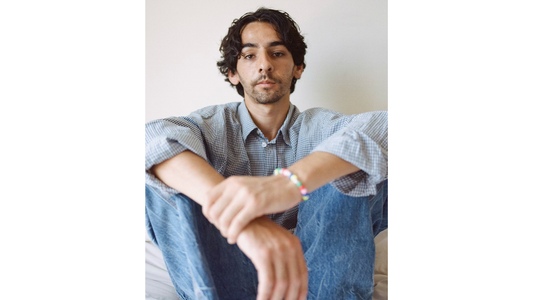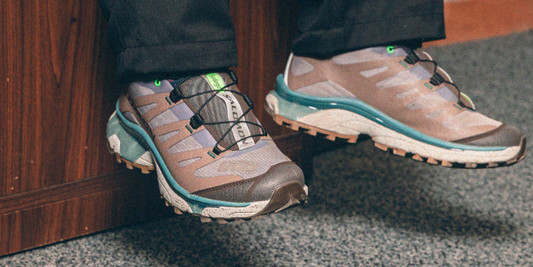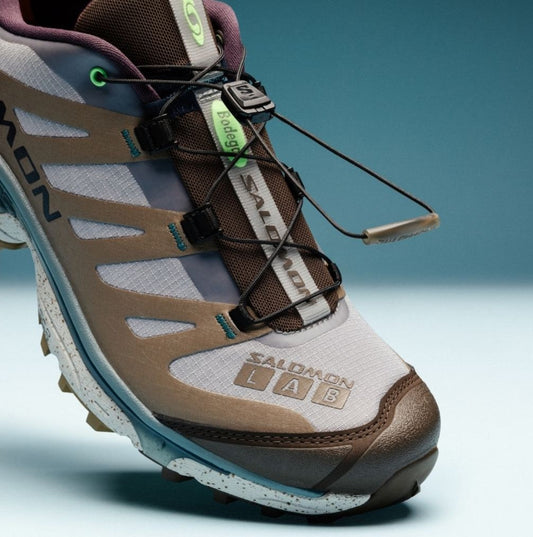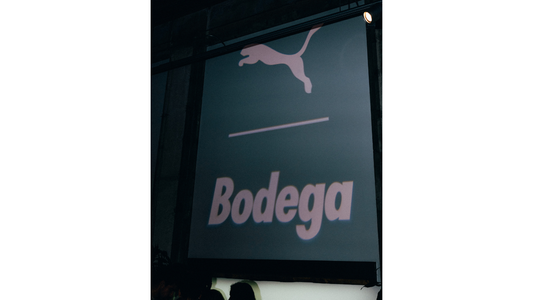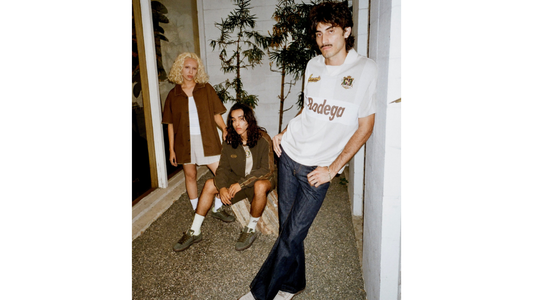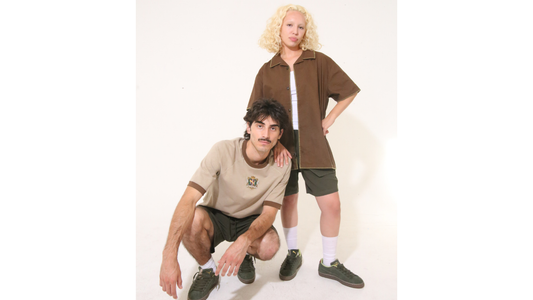Singlehandedly restoring our faith in the next generation of young creatives, mad scientists Sam Shorr, Willy DeConto, and the rest of the John, Rick, & Fritz Studio are bringing a youthful perspective to old-school entrepreneurship.
Revolutionizing and democratizing the world of stop motion animation through their Gif-O-Graf machine - yes that’s right, a physical, tangible invention - it is no surprise that schools, libraries, and other public institutions in Rhode Island and beyond are starting to pay attention to its far-reaching applications. To learn about the studio’s backgrounds, hear how the Gif-O-Graf got started, and discover what else the team has cooking, we took a trip down to Pawtucket for a tour of their space and a sit-down conversation as part of our Creative Community series.
Who is the crew?
(Pictured) Sam Shorr & Willy DeConto – founders of Gif-O-Graf. Michelle Authelet – friend, craftsperson, Gif-O Teacher. Charlie Fine – friend, cultural consultant, helps out with anything we need.
(Not pictured) Gif-O Extended: Celeste Diaz Falzone, Friend, artist. Zach Pearson, Conor McKean, Tim Moulton, Engineers. Walker Mettling, Artist. Kipp Bradford, Engineer. Oz Hewitt– Hacker, Synth Maker. Ayano and Shingo Tanaka, no longer Stateside but holding it down for Gif-O in JP/Taiwan – they were instrumental in the creation of Gif-O-Graf.
How did you guys meet?
Willy and Sam met in kindergarten. Have been scheming for over 20 years. We met Michelle through Celeste here in Rhode Island, and Charlie through one of Sam’s friends from high school.
What were your creative outlets growing up?
We were lucky enough to have very supportive parents who encouraged us to work on stuff outside of school. In high school, we began screen printing, which introduced us to photography, graphic design, the Adobe Suite, etc. We were always into making videos, t-shirts, graphics, etc…and we were particularly keen on doing things “professionally” even if we really didn’t know what we were doing.
What did you want to be?
Vaguely just anything “creative.” Also, just a burning desire to be “professional” as previously mentioned.
How important was/is style/ clothing/ design/ aesthetic/ etc?
Incredibly important! Hard to separate those categories. But yeah since middle school we’ve been interested in design– everything from graphics to architecture to clothing etc. It sort of started with a more surface-level interest in design on the aesthetic side, and now it’s balanced out with the idea/conceptual/business side of design.
Why did you guys choose Pawtucket RI?
Sam was living in LA and looking to move back East but didn’t want to move back to Mass. Willy stumbled upon this shop on Craigslist, and the rest is history! Fell in love with the city and state. Pawtucket has industrial and historical infrastructure, a wonderfully diverse population, and reasonably priced housing/commercial space. That combined with the fact that we found an amazing HQ at the Elks Lodge, has made it an ideal location to build a business and life.
"We use the space for prototyping all sorts of stuff like machines, displays, signs, making prints, hosting meetings, fleshing out ideas, making movies with kids, etc."
What is John, Rick, & Fritz?
JR&F is the design studio that Sam & Willy work out of. John, Rick & Fritz were Sam’s imaginary friends as a young kid. So when coming up with the name of a design firm, it seemed logical for the name of the partners. Historically we have worked with clients to do graphic and digital design – everything from application design to branding systems. Now, we primarily are focusing our efforts on Gif-O-Graf.
What is the Gif-O-Graf and how did the project get started?
About four years ago we were working for a client building a communication app for neurodiverse youth using affinity as a point of connection. One of the top affinities we observed amongst ND youth was animation. So, we decided to put the phones down and host an animation workshop. The results of the workshop were spectacular, but the process of setting up lights, a camera, a computer, hiring a professional animator to assist…needless to say, it was a lot. That was where the idea of building an “all-in-one” system came from. Gif-O-Graf is the world’s first all-in-one animation system. We now sell our systems to schools, libraries, and other public institutions.
What’s the G-O-G journey been like? From first prototype and first sale, to where you guys are at now?
Long and full of failure! That being said, we’re super psyched and kinda amazed that the Gif-O has gone from an idea to a fully-fledged 3D product in just a couple years— thanks to some great friends/partners along the way. We’ve realized a handful of products in the past, but never anything quite so physical (or full of electronics). We now have our fully commercialized unit, the V2 in production and ready for sale— tell your local librarian. Additionally, we’re always developing new curriculum and the digital side of things be it the machine software or GifoTV.
In an online world, what is the significance of creating a physical product that can increase people’s creativity?
We’ve been pretty bummed out talking to old art teachers and visiting schools – wood shops are few and far between, and kids seem to be more afraid to create. Maybe that's because they’re worried about being judged, or they just have less practice, but either way, people are less inclined to be creative. That being said, communication in the digital world is exciting. People communicate in a much more graphical and illusionary way now…which is pretty awesome. We’re excited about the Gif-O-Graf maybe being a bridge between those two worlds. You have to use your hands and work with your peers to create something, but the output is still a digital file that you can share on your phone. Gif-O-Graf does one thing: it lets you make cut-paper stop-motion videos. That simplicity, combined with the fact that there is not a lot of reference for cut-paper animation, has hopefully lowered the barrier to creativity.
Let’s talk about outreach/ application of the Gif-O-Graf real quick. When you give kids demos at schools or during museum walk-throughs etc, what are their reactions to working with your machine?
Generally, adults are more “impressed” but are hesitant to interact with the Gif-O-Graf. Kids on the other hand might not say much but they’ll just get completely absorbed as soon as they sit down at the machine. A lot of kids actually have some experience or knowledge of animation, so they sort of take the technology for granted— in a good way. The machine just disappears into the background and they completely focus on their creation rather than the technology enabling it to happen.
"...demystifying it [stop motion] demonstrates that you can create something that seems “magic” or highly complex with something as simple as paper, scissors, and snapping a bunch of pictures."
What animation do you have them make and why?
We like to start with our standard “Animators Exam”. We have little cards like you might get at a driver’s license road test, and students have to animate their way through the gauntlet until they’ve passed the basics.
One of these is the classic ball bounce. The students are simply animating a circle going up and down in a few frames… but it’s alllll in the nuance. We’re trying to teach the difference between simply moving an object versus injecting life into an object, or in this case injecting some gravity. Sometimes we’ll even grab a real-life basketball just to illustrate the point in 3D.
Why is it important to demystify stop motion animation, especially for the youth/ next generations?
Well, our internal tagline is “Make kids pro”. Not to say we want to churn out a generation of professional animators (although that’d be very cool). Moreover, the aim is to make our students really feel like professionals by taking them seriously and matching them up with the tools and skills to make their ideas more legit. So from a practical perspective, demystifying stop-motion is a great add to their creative skillset. But on a higher level, demystifying it demonstrates that you can create something that seems “magic” or highly complex with something as simple as paper, scissors, and snapping a bunch of pictures.
How would you describe your space? Any neat tools, toys, and objects you want to call out that tie it all together?
We love our space, it’s a classic “shotgun” layout with huge windows in front. It’s also at street level which is a totally different vibe than being tucked up on a higher floor, it really provides a ton of energy, and occasionally distractions... the styles walking through Times Square Pawtucket are out of this world. We use the space for prototyping all sorts of stuff like machines, displays, signs, making prints, hosting meetings, fleshing out ideas, making movies with kids, etc.
The cornerstone of the shop is the 4x8’ cutting table which is covered in a huge cutting mat. This gets used more than anything else from computer work to trimming books/prints to making animation characters, measuring, layouts… everything. Other key tools would be the Risograph, laser printers, and laser etching machine. And then books, tchotchkes, posters, and other inspirational ephemera.
While working as a team how do you deal with creative roadblocks / get inspired / clear your heads?
For inspiration, we get charged up from our general disappointment with the current built environment around us, often we’ll look to the past, for a time when everything was done with more pride and more quality. To clear our heads we like going across town to find a sweet treat. Recently we’re big on milkshakes, or we might even make a trip to Portugalia in Fall River. They do it old school, a real family business. They inspire us.
What is next for your studio?
In the short term, we just had the Boston Art Book Fair last weekend. Always a great event from Boston Center for the Arts and Bodega. Longer term just continuing to hone the Gif-O-Graf offering, making lots of animations with our students, trying to improve at our crafts, maybe even “go pro” ourselves. Also getting one of those mini milk fridges to go next to the coffee maker.
Pictured above, left to right: Charline Fine, Willy DeConto, Sam Shorr, and Michelle Authelet.


